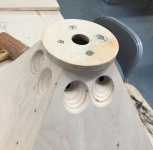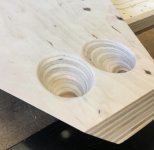Hi!
I've build a pair of unity horns this year. Active crossover with Nanodigi and seperate dacs.
They sound really nice although there is one thing which is bothering me. Each mid has 2 entry ports which I cnc'd in a way I thought would be best. But because of this chamfer form they 1, don't go much higher than 1kHz (due to the air trapped in the 'bandpass' space. 2. (the audible problem) because of this rather large space, they sound very 'boomy' like when speaking in a tin can or so.
How can I solve this? Filling them with a very soft material? (the speaker cone will hit this material probably but would that be a problem?)
Some pics to get a better idea
I've build a pair of unity horns this year. Active crossover with Nanodigi and seperate dacs.
They sound really nice although there is one thing which is bothering me. Each mid has 2 entry ports which I cnc'd in a way I thought would be best. But because of this chamfer form they 1, don't go much higher than 1kHz (due to the air trapped in the 'bandpass' space. 2. (the audible problem) because of this rather large space, they sound very 'boomy' like when speaking in a tin can or so.
How can I solve this? Filling them with a very soft material? (the speaker cone will hit this material probably but would that be a problem?)
Some pics to get a better idea
Attachments
You definitely do not want anything touching the cone. What drivers are you using?
previous build post
Unity horn, celestion + bms
??
Last edited:
How can I solve this? Filling them with a very soft material? (the speaker cone will hit this material probably but would that be a problem?)
IIRC, DSL recesses the drivers and shapes this 'plug' as required, i.e. it needs to be made rigid/dense. The desired squish area [net volume] required to get the best overall response will dictate how much clearance you can eek out of it.
GM
IIRC, DSL recesses the drivers and shapes this 'plug' as required, i.e. it needs to be made rigid/dense. The desired squish area [net volume] required to get the best overall response will dictate how much clearance you can eek out of it.
GM
So I think the best way is just to try a few ways and see how it sounds
Or you can measure the driver's specs and sim it in Hornresp.
GM
I'm not sure which would be faster since I'm quite a rookie in hornresp...
So the data from the other thread is this speaker? Looks like you are getting to about 1.3khz which is what I get with a similar setup....my counterbores for the ports are about half the size of yours though. What dia ports? I haven't been able to get any more HF output than what you are seeing.
How thick are your horn walls? The length of the port itself can be part of the problem. With thick horn walls and nicely tapered frustrum you can't help but trap too much air. Dial it back to half inch 12 mm horn walls and you won't need so much frustrum and you won't trap as much air. You also might find you can get by with smaller holes. As has been said, you really need to simulate in HR; alternative might be endless trial and error. HR isn't hard
I'm not sure which would be faster since I'm quite a rookie in hornresp...
OK, then the goal is minimal net volume Vb and port depth, which in turn allows a smaller vent, so plan it right and the frustum becomes the majority of the net Vb with the vent being a ~cardboard thin [if for HIFI-HT apps] hole with its end correction being basically its extremely short total acoustic length.
GM
Hi!
I've build a pair of unity horns this year. Active crossover with Nanodigi and seperate dacs.
They sound really nice although there is one thing which is bothering me. Each mid has 2 entry ports which I cnc'd in a way I thought would be best. But because of this chamfer form they 1, don't go much higher than 1kHz (due to the air trapped in the 'bandpass' space. 2. (the audible problem) because of this rather large space, they sound very 'boomy' like when speaking in a tin can or so.
How can I solve this? Filling them with a very soft material? (the speaker cone will hit this material probably but would that be a problem?)
Some pics to get a better idea
Everything that you describe here is normal. The midranges in a Synergy Horn cover a bandwidth of just 1.5 octaves (about 400 - 1200Hz.) If you listen to a Synergy Horn without the compression driver playing, it does indeed sound like a tin can. This is normal. If you took a really nice midrange driver and you filtered out all the highs and the lows, it would also sound like a tin can
So don't worry, you're doing fine, this is all normal. The next step for you is to get the compression driver 'dialed in.'
Everything that you describe here is normal. The midranges in a Synergy Horn cover a bandwidth of just 1.5 octaves (about 400 - 1200Hz.) If you listen to a Synergy Horn without the compression driver playing, it does indeed sound like a tin can. This is normal. If you took a really nice midrange driver and you filtered out all the highs and the lows, it would also sound like a tin can
So don't worry, you're doing fine, this is all normal. The next step for you is to get the compression driver 'dialed in.'
Hi! Good to hear, but I'll try some hornresp stuff, because now I'm crossing at 1000 hz, littlebit higher would be nice for the cd I think.
By dialing in you mean get the 1/4 wavelength right? I'm using the BMS4550 with a little delay because at the time I didn't know about the bms having this extra path length due to the diaphragm (forget the type of diaphragm they used)
Basically you want to juggle the crossover frequency, slope, phase, and delay to get flat response in the octave from 1000Hz to 2000hz.
If you really know what you're doing you can get everything dialed in with no delay. JLH has been able to do that, I've been able to do that occasionally.
Sometimes it's not possible to pull it off. In that case, you just have to scrap the whole thing and start over again. That happened to me here:
Soundbar Bateman Style
Side note: I'm not sure if you can make it work with a crossover frequency below 1500Hz. Synergy horns kinda depend a fairly shallow crossover slope. Also, the BMS compression drivers don't like to be crossed over very low. A ring radiator has less displacement than a conventional compression driver.
If you can get the woofers to play above 1000Hz you might consider different woofers. What woofers are you using?
If you really know what you're doing you can get everything dialed in with no delay. JLH has been able to do that, I've been able to do that occasionally.
Sometimes it's not possible to pull it off. In that case, you just have to scrap the whole thing and start over again. That happened to me here:
Soundbar Bateman Style
Side note: I'm not sure if you can make it work with a crossover frequency below 1500Hz. Synergy horns kinda depend a fairly shallow crossover slope. Also, the BMS compression drivers don't like to be crossed over very low. A ring radiator has less displacement than a conventional compression driver.
If you can get the woofers to play above 1000Hz you might consider different woofers. What woofers are you using?
Last edited:
Cool, this should be fairly easy then! You're using the same compression drive and midrange drivers that Danley is.
So the 'trick' is getting the geometry of the midrange taps correct and the crossover.
Here are the location of the taps in the Danley speaker:
Midrange taps are 3/4" in diam, 3.5" from throat
Woofer taps are 2.5" in diam, 10.5" from throat
Woofer ports are 2.5" in diam, 14.5" from throat
Where are yours? And how deep are they?
So the 'trick' is getting the geometry of the midrange taps correct and the crossover.
Here are the location of the taps in the Danley speaker:
Midrange taps are 3/4" in diam, 3.5" from throat
Woofer taps are 2.5" in diam, 10.5" from throat
Woofer ports are 2.5" in diam, 14.5" from throat
Where are yours? And how deep are they?
The bms 4550s in my synergies are crossed at 1050 Hz with a 24 db electrical slope and EQed to hit 48 db slope so I think you are on the right track.I bought the bms because of the fact that it could be crossed at 800hz and up.
I'm using four celestion tf0410mr mids now.
too little slope will sound harsh. On my 90x45 horn they fell on a 24 db slope with no filter
I think you have your mids going high enough, even though not as high as BWaslo's. If you want to go high likely have to address air under cone.
- Status
- This old topic is closed. If you want to reopen this topic, contact a moderator using the "Report Post" button.
- Home
- Loudspeakers
- Multi-Way
- Unity horn bandpass sound

